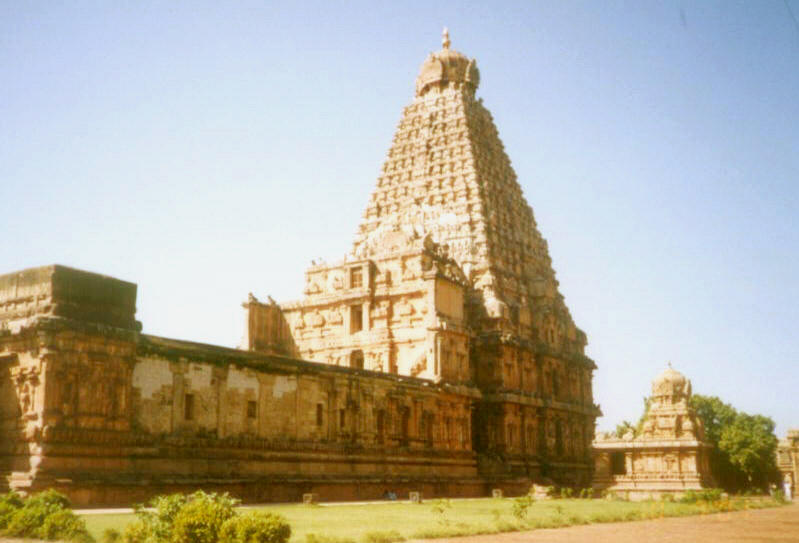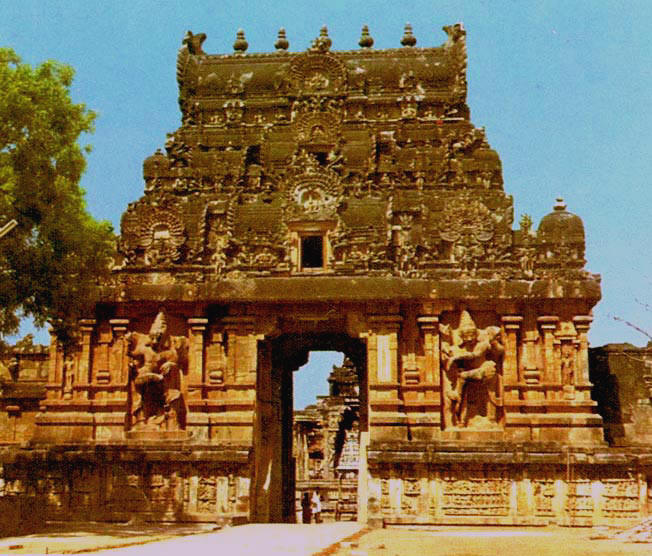

Entrance to Rajarajesvaram
"Rajarajesvaram in the Tanjavur district of
Tamil Nadu has often been called `the temple of temples'. Built
round the turn of the first millennium A. D. during the heyday
of Chola rule, it is perhaps one of the best expressions of
artistic excellence that could be conceived of.
For the Cholas, temple building was not merely
an outpouring of artistic talent but also away of life, for the
entire fabric of the society was woven round the temple.
Built by the greatest of Chola rulers, Rajaraja,
the temple was named after him as Rajarajesvaram, meaning `the
temple of the Isvara (God) of Rajaraja'. Later on, it became
known as the Brihadisvara temple meaning the temple of the
`Great Isvara'. But, in fairness to the great king who
visualized and had this structure built, I have, following my
father, adhered to the original name.
I have chosen this temple as the theme of this
book because it is a unique monument in many respects.
It attracts the curiosity of not merely the
historian but also the sociologist, not to speak of the dancer
and the painter for, it is perhaps the only temple in the world
which carries on its walls the engraved evidence, in beautiful
calligraphy, of its entire history and the story of the
contemporary society.
Such an exhaustive documentation ranging over
almost a hundred long inscriptions engraved on the walls,
pillars and podium, is rare wealth, indeed of immeasurable value
to the scholar.
The inscriptions give, apart from a
comprehensive history of the times, a full enumeration of all
the metallic images set up in the temple. Numbering about
sixty-six, these icons are referred to with a description of the
minutest details of size. shape and composition. This alone is a
mine of information for the art historian.
The temple also sports a depiction in stone, of
eighty one of the one hundred and eight karanas of Bharata
Muni's Natya Sastra - the first of its kind - setting the pace
for many others to follow in succeeding centuries.
The inseriptional data also abound in mention of
the jewellery of the period; about sixty-six different types of
ornaments and jewellery are listed with all the details.
As if this were not enough for the scholar,
there is a fund of material on the social and cultural life of
the people of the times.This single temple could give the lie to
the erroneously held and oft repeated contention that the Indian
community lacked a sense of history.
I have chosen this subject, not merely because
of my general interest in and involvement with art history of
the Cholas for over three decades along with my illustrious
archaeologist father, but also because no painstaking attempt
has yet been made by any scholar to place all this treasure of
information in a single capsule for the scholar or the
traveller.
The history gleaned from the temple walls will
not make much sense without an idea of the background of Chola
rule and hegemony. Hence I have devoted the first chapter to
`The Rise of the Chola Empire' thus bringing before the reader
the exact historical context of Rajarajesvaram.
The second chapter on `Rajaraja the builder',
not merely enumerates his attainments as a ruler, but also gives
a clue to his personality and the psychological forces that
prompted his building this fine edifice. This is particularly
important in the case of Rajarajeswaram, for the temple bears
the indelible imprint of the mind that conceived it. In the same
chapter, I have also dealt with the contributions of Rajaraja's
great aunt, Sembiyan Mahadevi and the tremendous influence these
had on Rajaraja and hence on Rajarajesvaram.
The details of Rajaraja's conquests, his army
and navy, his administrative ability and his religious
tolerance, are gleaned from the inscriptional evidence on the
temple walls.
The next chapter brings out the detailed
description of the temple itself. An all stone structure of such
stupendous proportions had never been attempted before. In
height, elegance and simplicity of design and plan, the temple
has few parallels.
Chapter IV deals exclusively with murals and
dance panels that stand revealed on the walls, thanks to the
ravages of Time which had more or less peeled off the late Nayak
paintings that had been super posed on the earlier Chola
paintings.
The Bharatanatyam panels have been a source
of great attraction to the curious scholar and the dance
theorist, as also to the performing artiste. To give a
general picture of how these panels correspond to the Natya
Sastra verses, I have illustratively elaborated on six of the
sculptured panels.
Chapter V consists of the details of the
metallic images gifted to the temple of Raj arajesvaram. A
complete list of the images, with the metal used and the persons
who made the gifts, has been given. The inscriptional details
have also helped to identify some of the existing specimens in
the temple.
Rajaraja's own gifts to the temple form a
separate chapter (Chapter VI). They included war booty, apart
from other articles the king specially ordered for his beloved
deity. The next Chapter (VII) deals with his sister Kundavai's
impressive additions to the temple.
Chapter VIII contains information on ancient
Indian jewellery that has not so far been brought to the
attention of the discerning scholar in such detail in one place
as I have been able to garner. My studies in this connection
have revealed some fascinating items of jewellery and, for the
first time, this book should be bringing into focus, apart from
other details, a comprehensive list of jewellery and ornaments
in vogue during the days of the Cholas. The types of jewellery,
the composition and the content, the highly advanced techniques
in fashioning them, have all been touched upon. Indeed, these
details alone could be the subject of yet another study, for the
Chola inscriptions mention twenty-three varieties of pearls, and
eleven very clearly defined varieties each of diamonds and
rubies alone; which only shows how exhaustive is the recording
left behind for posterity.
I have also included a brief chapter (IX) on the
vessels and other aids used in temple rituals.
The administrative arrangements for the
maintenance of the temple are described in another exhaustive
chapter (Chapter X). Once again a wealth of details is contained
in the inscriptions. The meticulous engraving of even the names
of the streets in which the shepherds and the temple women
lived, not to speak of their own names and other details, is a
case in point to illustrate the Rajarajan eye for detail and
documentation. Nothing had been left to chance.
In the last chapter, I have dealt with the
fortunes of the temple under post-Rajarajan rulers for, such a
stupendous monument could not but attract the attention of later
monarchs and noblemen.
Apart from these eleven chapters, I have
attached elaborate (thirty two) appendices dealing with almost
every facet of the temple and its context. They include a wide
range of material, starting from a list of temples of the period
of Rajaraja I, covering inscriptional details, quoting list of
icons, ornaments, vessels, streets where temple functionaries
lived, names of army units and regiments, villages offered to
functionaries as remuneration for services rendered etc.
I have also included a select set of photographs
of the temple besides line drawings illustrating details of
jewellery, hair style, sculptural contours and main
architectural features.
A temple for the Cholas was not merely a house
of worship. It was the fulcrum of life, for the king linked
himself closely with the deity of his choice. War booty was
gifted to the temple which was the Treasury as well as the
Public Record Office.
The king's coronation was celebrated in the
temple which was also the patron of music and all other
performing arts. The learned scholar, the sculptor and the
architect, the dancer and the musician, the blacksmith and the
carpenter, and a host of others depended on the temple for their
livelihood. Thus, the temple was an institution the actiyities
of which touched upon every aspect of a person's life.
In the case of Rajarajesvaram, a concise
presentation of all the intense research that has been done in
the past and is still continuing is more than warranted.
Apart from the importance it shares in general
with other Chola monuments, it is a sculptor's dream, a
historian's mine, a dancer's vision, a painter's delight, a
sociologist's scoop, all rolled in one."
|